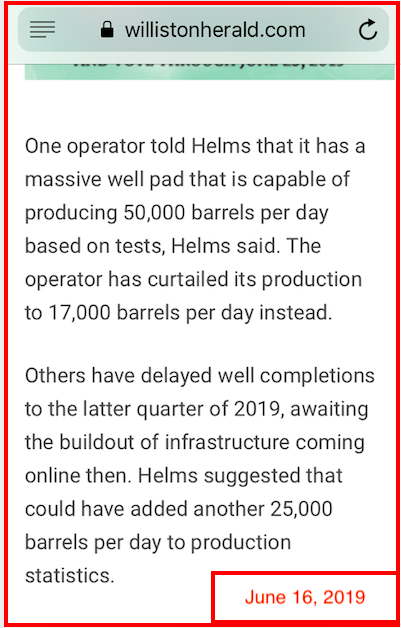Re-posting from June 16, 2019.
From The Williston Herald, this screenshot:
50,000 bbls of oil per day. Let's say the "massive well pad" has
fifty wells. Each well would be capable of producing 1,000 bbls of oil
per day, or 30,000 bbls of oil per month.
Assuming no error in the message or the reporting.
Note: CLR is not based in Denver, CO. Slawson and Whiting are.
Disclaimer: I am inappropriately exuberant about the Bakken.

The overall improvement has happened ND-wide. It's basically a trend up from 2014 to present. Most of the improvement was from 2015 to 2017.
ReplyDeleteHess is similar to CLR in being a bit of a proxy for the ND average performance. See table below, gathered from shale profile.com. The numbers are the 12 month oil cums.
year NDavg Hess Hess%ND CLR CLR%ND
2018 175 159 91% 167 95%
2017 160 170 106% 173 108%
2016 127 112 88% 142 112%
2015 103 90 87% 102 99%
2014 94 81 86% 87 93%
Thank you very much for taking time to write. Much, much appreciated.
DeleteAnd, of course, the big question is this: what accounts for that overall improvement from 2015 - 2017?
That has been discussed on the blog - the change in frack strategy/completions, was just part of the answer, but probably the most significant part of the answer.
But then this: what drove the change in frack strategy/completions? If you recall, it was 2014 - 2016 that Saudi Arabia opened their taps, attempted to flood the world with oil; drove WTI (or Bakken) down to $20/bbl (?); tried to crush the US shale operators. The US shale operators responded -- a book could be written about that -- one should see all the permits that were canceled in those two years. The US shale operators had to do something to survive.
Huge story. Fascinating story.